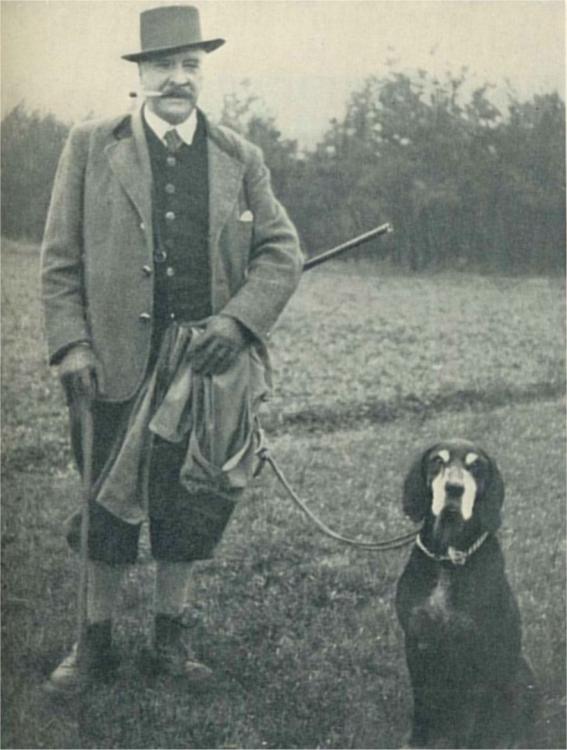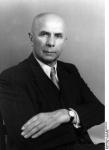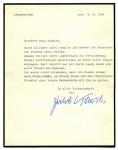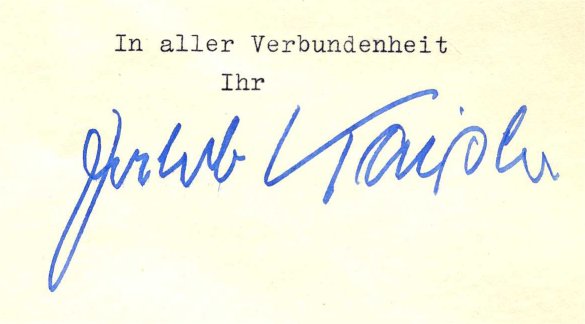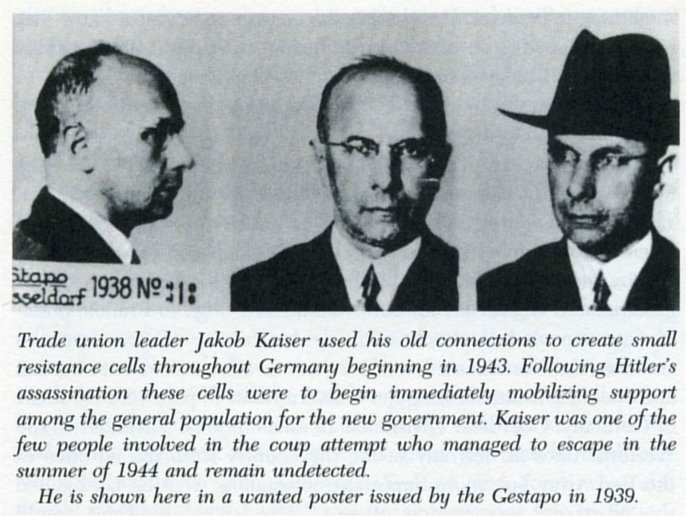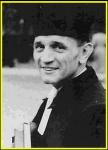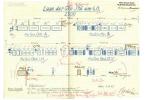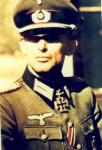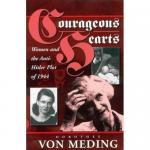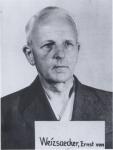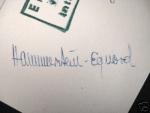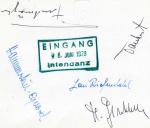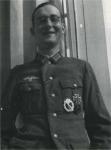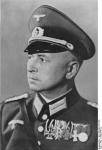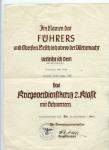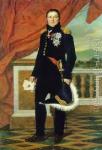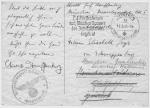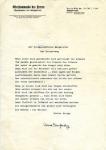-
Posts
701 -
Joined
-
Last visited
-
Days Won
1
Content Type
Profiles
Forums
Blogs
Gallery
Events
Store
Everything posted by ColinRF
-
Berthold Graf von Stauffenberg - Claus' Uncle, not his brother - was not a resister. But nevertheless he died as a result of Claus' assassination attempt. His signature appears on the memento document that once belonged to Claus (posted earlier in this string at http://gmic.co.uk/index.php?showtopic=34308&view=findpost&p=323560). Berthold was Colonel of 1. Bayerisches Schwere Reiter in WWI. The following excerpt from the memoirs of Elisabeth von Guttenburg (Holding the Stirrup) describes his last days: "Almost daily, word was received of the tragic death of some close friend or relative at the hands of the Gestapo. I had scarcely reached home when I received a message from one of the guards at the civil prison in Wiirzburg. This guard said that he had always had great respect and admiration for Old Count Berthold Stauffenberg. He informed me that Count Berthold was gravely ill in the hospital in Wiirzburg. So Berthold was not in Silesia with the others! Nothing would keep me from seeing this dear friend before he died. I set out immediately for Wiirzburg. It was late at night when I reached the hospital. In spite of the Nazi persecution of religion, nuns were kept on the nursing staff of many hospitals. The sister who was assigned to care for Count Stauffenberg took me down dark hallways and up back stairs-without lights and on tiptoe. Like a thief, I made my way to the room. At last we came to a door which she un-locked. The room was scarcely more than a cell; Berthold was a prisoner and not a patient. I had to stifle a cry. What a sight! On an iron cot lay a man, thin as a skeleton, his face like that of an old bird's. If I had not been told that this was Berthold Stauffenberg, I would never have recognized him. I could not believe that this human wreck was Berthold. He did not recognize me; his mind wandered as he babbled incoherently. His hands moved constantly on the bed cover as though searching for something. I learned that, for no medical reason, he had been given injections in prison. Under the effect of drugs his strong and vital mind and body had gradually given way. There was nothing that I could do for him. I took his old, claw-like hand in mine and prayed. I was told. that he would not live more than a day or two; so I decided to stay with my mother-in-law, who was living in our Wiirzburg home. The news about Count Berthold was a terrible shock to her for they had been friends from childhood. She was now eighty-two years old, and I could see that she was failing rapidly. I tried to persuade her to return to Guttenberg with me, but she refused to go. The end came swiftly for Berthold Stauffenberg on November 9, I944. The Gestapo forbade anyone to at-tend the burial, but a few of us, including my brave, courageous mother-in-law, accompanied the coffin to the cemetery. There, at the graveside, to our astonishment and joy, stood the Bishop of Wiirzburg in full vestments. He also had defied Gestapo orders! Farewell, Berthold, beloved, knightly friend!"
-
Letter signed in 1954 by Jakob Kaiser, a socialist politician and close friend of Claus von Stauffenberg. Kaiser was one of the few survivors of the innermost group of plotters. Trained as a bookbinder, he joined the Centre Party in 1933 and was one of the more important trade union leaders under the Weimar Republic. He was a representative in the Reichstag until November 1933 and, from 1924 to 1933, he was a member of the Executive Committee of the Christian Trade Union. Kaiser was an early opponent of the Nazis. In 1934, he joined the resistance movement and worked closely with Wilhelm Leuschner and Max Habermann. With them, Kaiser spoke out in support of a single amalgamated labour union. He spent several months under Gestapo arrest in 1938 under suspicion of treasonable activities. After 1941, he continued to resist Hitler and he collaborated with Carl Friedrich Goerdeler and other leaders of the military opposition. In the run up to Valkyrie, Kaiser was personally involved in last minute strategic planning, performing a role similar to a member of the conspirators' Board of Directors. Kaiser was involved in drawing up the lists of Wehrkreis political representatives. He was also a close friend of labour union leader Julius Leber, Stauffenberg's close friend and mentor, who was arrested by the Gestapo a short time before July 20. Kaiser had tried in vain to dissuade Leber from attending a meeting between labour leaders and communists that was infiltrated by a Gestapo informer. Leber was arrested as a result. Kaiser also took par tin several high level meetings to plan the nature of the German government after the success of the coup. He met Stauffenberg several times in June and July 1944, being much impressed by his personality, just as many others before him were. After the unsuccessful assassination attempt of July 20, 1944, Kaiser was wanted by the Gestapo. However, with the aid of his later wife and long-time political associate Elfriede Nebgen, he was one of the few who were able to successfully go underground, hiding in a cellar in Potsdam-Babelsberg. Kaiser was the only survivor of the inner circle of the resistance in Berlin. His wife Thérèse and the older daughter Elisabeth were taken into custody, as were his wife's brothers. After the war, Kaiser founded the CDU party with Andreas Hermes and Joseph Ersing. Ahead of this time, he favored a non-aligned Germany that would perform a bridging function between West and East. After a distinguished political career, Jakob Kaiser died in Berlin after a long illness on May 7, 1961. He received many posthumous honours throughout Germany after his death.
-
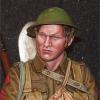
OBE citations?
ColinRF replied to ColinRF's topic in Great Britain: Orders, Gallantry, Campaign Medals
Great ideas - thanks. If I find anything I will post it here. Colin -

OBE citations?
ColinRF replied to ColinRF's topic in Great Britain: Orders, Gallantry, Campaign Medals
That's way more than I knew so thank you very much for your rapid response! Are citations always created for this award even if not published? I would just like to know so I can decide whether to expend energy trying to hunt it down. Colin -
My grandfather got an OBE soon after WWII. Handed down family history is that we was (the?) senior fire officer on site during the bombing of Coventry in 1940. I know he was there and would like to know more about his role and if there is more to the official story. Anyone know if awards like OBE's come with any official citation or explanation or do they just appear on the awards list as a result of a back room process that is not made public. I found a Gazette for him - for the fire service medal. Alick Haydon FINNEY, Fire Force Commander, No. 23 (Stoke) Fire Force. http://www.london-ga...s/2820/page.pdf Nothing else though - anyone in officialdom I could write to? I also have his miniature medal bar of 4 medals. Not sure what they are but no OBE. Thanks Colin
-
Friedrich Gustav Emil Martin Niemöller was an anti-Nazi theologian and Lutheran minister. Niemoeller was not an active resister as he was already under arrest in 1937. However, Niemoeller’s example was felt by his peers, including Dietrich Bonhoeffer, and his congregation, which included the brothers von Haeften and Ulrich von Sell. Niemoeller was a decorated U Boat commander in WWI. He was a monarchist conservative and like many other soldiers and aristocrats in the resistance, he was initially supportive of the Nazis. He was one of the founders of the Confessing Church, which tried to some extent to halt or turn aside the Nazis’ take over of the traditional Christian churches. For his opposition to the Nazis' state control of the churches, Niemöller was imprisoned in Sachsenhausen and Dachau. He narrowly escaped execution as part of the column of Sippenhaft and other VIP prisoners. After his imprisonment, he expressed his deep regret about not having done enough to help the victims of the Nazis. He turned away from his earlier nationalistic beliefs and was one of the initiators of the Stuttgart Declaration of Guilt. From the 1950s, he was a vocal pacifist and anti-nuclear activist. In 2008, I had the honour of hearing Niemoeller’s widow and daughter of conspirator Ulrich von Sell provide her memories of growing up in a resistance household. Amazing to hear history from someone who experienced it personally! Niemoeller is most famous for his iconic poem: They came first for the Communists, and I didn't speak up because I wasn't a Communist. Then they came for the trade unionists, and I didn't speak up because I wasn't a trade unionist. Then they came for the Jews, and I didn't speak up because I wasn't a Jew. Then they came for me and by that time no one was left to speak up.
-
I just received a fascinating file of student materials from a c.1937 Austrian war studies course. The approx. 40 pp. of material appears to include a marked theoretical problem focused on logistics. The solution is stamped and signed by Oberleutnant Heinrich Kodré. Kodré would go on to a distinguished career as a general staff officer in the Wehrmacht, winning a Knight's Cross, suffering a serious wound attacking the Barrikady at Stalingrad, playing a major role in the bomb plot and finishing up in KZ Mauthausen. At Stalingrad, Kodré was wounded three times and flown out, probably to minimize the number of highly decorated officers falling into the Soviet net. He received a poor evaluation from his absent division commander although this seems to have been ignored as he was subsequently promoted. His assessment from the time reads: "Fully proven as a divisional chief-of-staff during the summer campaign of 1942. During the fighting in Stalingrad, responsibility for commanding the division lay completely with him at times because his division commander, without reporting himself ill, was impeded by a nervous disorder. Kodré could not completely cope with this overload, to which his own state of health contributed." On July 20, 1944, Oberst Kodré was Chief of Staff to the Deputy Commanding General of Wehrkreis XVII in Vienna. Kodré's commander General von Esebeck was absent on July 20 when the "Valkyrie" command was received. Both Kodré and von Esebeck were in the know about the plot. Kodré was acquainted with other Austrian resisters including Robert Bernardis, Rudolf von Marogna Redwitz, and Erwin Lahousen-Vivremont. The coup's effectiveness in Vienna was second only to Paris. While all ranks of SS, SD and Gestapo were arrested in Paris, only senior police, party and security functionaries were put on ice under a rather gentlemanly house arrest in Vienna. But arrested they were. Only when it was painfully evident that the plot had misfired in Berlin did Kodré release his prisoners with apologies. Kodré was arrested by the Gestapo but faired better than his alternate numbers in Paris. He was locked in solitary confinement and taken to a camp in Fürstenberg in Mecklenburg. In court he was acquitted for lack of evidence and based on his "only following orders" defence, then set free and placed in "reserve officer" status. In early November 1944 he was again arrested and kept in solitary confinement until early January 1945 in the Vienna police jail. On 31 January 1945, he was expelled from the army. He was then moved as a political prisoner to the Mauthausen concentration camp. His treatment improved in mid-April 1945 when it became apparent to the guards that Germany faced inevitable defeat. On 5 May 1945 he took command of the security forces formed to protect prisoners in the camp. He held this position until 3.30 PM on May 6th, when he secured the Mauthausen railway bridge and then handed over the command to a Soviet commander. On 15 May 1945 Kodré was released from Mauthausen. Just before the reorganization of the Austrian army in the autumn of 1955 he published a series of articles in which he criticized the reorganization. As a result he was not taken into the new army was not. In 1958 he was Secretary to the Ministry of Interior and Civil Defense. He died on 22 May 1977 in Linz, Austria.
-
Doc - she was a very classy and wise woman. I highly recommend the book the quote comes form. I have a large library on the bomb plot including all standard texts and bios in English and many in German. This book ranks in the the top 5 along with Hoffmann's classic "History of the German Resistance" and "Stauffenberg." Its a superb book of interviews of the women in the lives of those resisters who did not survive. I particularly liked Margarethe von Oven's piece on Henning von Tresckow. I can't recommend this work enough. Colin
-
Its relatively easy to pull together a good collection when you specialise in a niche area and are paitent. Add a little luck and available funds at critical moments when once in a lifetime opportunties arise. Interesting to have the history you write about in your family. Freisler has the misfortune to be ranked among the more odious Nazis - deservedly so in my view as he seems to have been completely corrupt, blowing with the communist or Nazi wind and enjoying humiliating brave men for his own advancement. The hanging curtains story is a great family story. I have had the opportunity to add his signature to my collection from time to time. I couldn't bring myself to do it, partially due to cost and partially because I really don't want to expand the collection to the regime. Also its harder to get 'controlling shareholder' (aka wife) approval for such acquisitions. I will stay with the resisters I think. Good for your uncle that he got out of the Nazi judicial branch and did something more respectable. I have recently added a few more signatures tot he collection and will post them when they arrive in the mail. I am alos looking forward to working with a local academic who is writing a book on the bomb plot and some of the lesser knowns. Cheers Colin
-
Signed photo of Ernst Freiherr von Weizsäcker as Secretary of State at the Foreign Office from 1938 to 1943 and German Ambassador to the Vatican until 1945.. Weizsäcker was born in Stuttgart to Karl Hugo von Weizsäcker Prime Minister of the Kingdom of Württemberg. In 1900, Weizsäcker joined the Imperial German Navy and served as an officer, including as Flag Lieutenant to Admiral Reinhard Scheer aboard the German flagship Friedrich der Grosse during the battle of Jutland. In 1917, during the latter portion of World War I he earned the Iron Cross (both classes) and was promoted to Korvettenkapitän. Weizsäcker joined the German Foreign Service in 1920 and was appointed as Consul to Basel in 1921. He served in many senior European capitals until he became Director of the Policy Department at the Foreign Office in 1937. The following year he was appointed as State Secretary, ranking second only to the Foreign Minister in the German Foreign Office. A In common with other senior government appointments, this posting was accompanied by rank in the SS. Weizsäcker claimed after the war, with several reputable witnesses backing him up, that he only remained in his position to work against Hitler’s plans to cause a major European war. Subsequent historical evidence tends to support this view. However, Weizsäcker was seen by the Western Allies, at least publicly, as a fully engaged member of Hitler’s bureaucracy. This may be because Weizsäcker knew too much about pre-war efforts by later resisters such as Ewald von Kleist, Adam von Trott and Helmuth James von Moltke to encourage the British government not to appease Hitler. Instead, Chamberlain’s government ignored warnings by these senior representatives of the resistance and invitations to stand firm against Hitler in favour of settling at the Munich Conference in 1938. It seems clear that Weizsäcker was an enemy of Hitler and that he shared the opinion of Ulrich von Hassell that the Final Solution was a "devilish campaign." In his messages to Berlin, Weizsäcker purposely painted Pope Pius XII as mild, diplomatic, indecisive, and pro-German, in order to help the Pope and to avoid anti-German sentiment in Italy. Like the commanding Waffen SS General Karl Wolff, Weizsäcker was clearly opposed to Hitler’s plan to occupy the Vatican, during which, Weizsäcker feared, the Pope could have been shot, "fleeing while avoiding arrest." Weizsäcker was indirectly supportive of Hans Oster’s plan to arrest or kill Hitler in 1938, should the attack on Czechoslovakia have been carried out. He had full knowledge of Erik Kordt’s plans to allow Friedrich Wilhelm Heinz’ team of commandos into the Chancellery to arrest or murder Hitler. After the end of the war, Weizsäcker initially remained in the Vatican City with his wife, as a guest of the Pope and a member of the diplomatic corps, only returning to Germany in 1946. Weizsäcker was arrested on July 25, 1947, in Nuremberg in connection with the Ministries Trial, also known as the Wilhelmstrasse Trial, after the location of the German Foreign Office in Berlin. This American military tribunal started before and finished during the Berlin blockade confrontation with the Soviets and proceeded without participation of the USSR. No European judges were involved in the trial, which was very controversial because Weizsäcker was considered by many to be closely associated with the anti-Nazi resistance and as a moderate force at the Foreign Office during the war; Winston Churchill called his trial a "deadly error." Weizsäcker was charged with active co-operation with the deportation of French Jews to Auschwitz, as a crime against humanity. His son Richard (later President of the Federal Republic) appeared as his assistant defense counsel (he was a law student during the trial), claiming that he had no knowledge of the purpose for which Auschwitz had been designed and believed that Jewish prisoners would face less danger if deported to the east. In 1949, the Americans sentenced him to 7 years in prison (one of the three judges voted to acquit him), but the same year, the sentence was reduced to five years, and the following year, he was amnestied, thus removing any legal remembrance of the sentence, and he was freed. He subsequently published his memoirs, in which he portrayed himself as a supporter of the resistance. He died of a stroke in 1951. Weizsäcker was a member of the prominent Weizsäcker family, and the father of German President Richard von Weizsäcker and physicist and philosopher Carl Friedrich von Weizsäcker
-
This June 1978 party invitation to Ludwig von Hammerstein-Equord and his wife was signed on the reverse by Hammerstein as well as “Triumph of the Will” director Leni Riefenstahl. Hammerstein was one of two sons of Kurt von Hammerstein-Equord who had been head of the German army in the years before WWII. The elder Hammerstein was an early and virile opponent to Hitler, threatening to arrest the Fuehrer if he ever visited his HQ. As C-in-C, Hammerstein lived in the Bendlerstrasse complex in a private apartment. Ludwig grew up there and was very familiar with the layout, a key factor in his escape from the Gestapo on the early hours of July 21. Hammerstein and his brother Kunrat were both on leave in Germany recovering from war wounds when Valkyrie occurred. Like many other resisters and other junior officers who were seconded to support the coup by Fritz Dietlof Graf von der Schulenburg, Hammerstein was a member of the 9th Potsdam Infantry Regiment, a unit that Axel von dem Bussche noted had more officers arrested or executed for conspiring against Hitler than any other. Both Hammerstein brothers were present throughout the day until the eve when the final gun fight broke out in the Bendler and Stauffenberg was wounded by “loyal” officers. Ludwig was attached to Stauffenberg while Kunrat was a courier for Goerdeler. seeing that discretion was the better part of valour, Ludwig Hammerstein left by a little known back stair prior to the Berlin Guard Battalion and the Gestapo gaining full control of the site. However, he left his maps and pistol behind as evidence of his complicity. He initially hid in a nearby city park and then fled to his home, staying long enough to say goodbye to his mother. Ludwig and his brother, who escaped from the Bendler in similar circumstances, both went underground in Berlin, using one of the ‘rat lines’ that existed to shelter Jews. Until April 1945, Ludwig stayed with the widow of an officer killed in Russia who was already sheltering a Jewish woman. Hammerstein’s mother and siblings were arrested as Sippenhaft prisoners, becoming part of the large column of prisoners liberated by US and Heer forces in Italy prior to their execution by the escorting SS guards. After the war, the Hammerstein family spread across the globe with many settling in the U.S. and others in Australia and Canada. They also intermarried with other surviving July 20 surviving family members. Two sisters became communists and other parts of the family inter-married with Jewish families. Kurt Hammerstein, an enlightened man ahead of his time, would have been proud of all of them. Update October 2016 - It has come to my attention that this Hammerstein signature may have been misattributed and that it may no in fact be that of Ludwig. I shall research further and confirm by way of a new post when I am sure.
-
I just received this urkunde for the War Merit Cross Second Class with Swords, signed by Eduard Wagner as Deputy Chief of Staff and Quartiermeister General of the German army. It is unclear how early Wagner became heavily involved in the conspiracy. Specialist historians count his involvement from as early as the Oster conspiracy in 1938 when he joined the conspiracy with Stuelpnagel. Other historians looking to cast Wagner in a less favourable light claim that he was a late addition, joining in early 1944 and only when the Russians began to threaten German borders. Throughout the run up to July 20, Wagner was heavily involved in planning the coup. In May 1944 he traveled to France to co-ordinate coup plans with Rommel. Wagner briefed the Desert Fox on previous coup attempts and he found the Field Marshal to still be against assassination at this time. He met with Lindemann, Fellgiebel and Stieff on July 3 at the Bertchtesgadenhof Hotel to discuss preparations. On July 14, he pushed Stauffenberg to ensure that Himmler was present before carrying out the attack. Wagner was informed of the impending attack on July 18 and spent an hour hunting rabbits with Stauffenberg and talking over preparations on July 19. On July 20, Wagner was responsible for supplying Stauffenberg and Haeften with their speedy Heinkel 111 aircraft for leaving Wolfschanze after their bomb attack on Hitler. Wagner was told of the attempt at about 1:30 on July 20 by Fellgiebel's Chief of Staff Kurt Hahn and soon after learned of Hitler's survival. Wagner's office passed to code word "Exercise" to Paris, signalling the start of the coup there. Field Marshal von Witzleben and his ADC Graf Zu Lynar visited Wagner at Zossen before moving on to the Bendlerstrasse to criticize the conspirators for messing up. He returned to Wagner at Zossen to report the status of the coup and abruptly left after 5 minutes with the comment "We're going home!" Recent revisionist historians in Germany investigating the involvement of the Heer with war crimes and the Holocaust have tried to link Wagner to atrocities by arguing that he met with Heydrich before the invasion of Russia and agreed to provide logistical support to the Einsatzgruppen killing squads roaming in the army's rear areas. Wagner seems to have been aware of the planned roll of the SS in suppressing partisan activity but it is not clear that he knew that the plan was to slaughter civilians en masse. Wagner was highly incriminated due to his meetings with Witzleben and from providing Stauffenberg's mode of escape on the 20th. On July 23, 1944, at 12:41 PM, he committed suicide in his office in Zossen by shooting himself in the head. He determined that this would be the only way to avoid torture and betrayal of other members of the conspiracy.
-
He looks like General Gerard a bit. No clue if the medals match. My copy of Six' Generaux et Amiraux.... is a few floors away at the moment. Colin
-
A known authentic left hand Stauffenberg (I believe that this is the actual signature included in Charles Hamilton's book). Sold in June by stargardt in Berlin for an astonishing 22,000 Euros. The catalogue listing was as follows: 1193 — STAUFFENBERG, Claus Schenk Graf von, Oberst im Generalstab; 1944 Stabschef des Befehlshabers des Ersatzheeres, führte das Attentat vom 20. Juli auf Hitler durch, 1907–1944 (standrechtlich erschossen). Feldpostkarte m.U. „Claus Stauffenberg." München 14.V.1943. Leicht fleckig. (1.200. min bid) An Elisabeth Freiin Geyr von Schweppenburg, Leiterin der Heim- und Heilstätte für Kinder und Jugendliche „Die Waldwiese" in München-Solln, mit dem Dank für ihr Gedenken anläßlich seiner Verwundung. „... Obwohl, wie ich glaube, meine Mutter Ihnen bereits meinen Dank für Ihre gütigen Zeilen und herrlichen Tulpen übermittelt hat, muß ich Ihnen doch noch einmal selbst meinen ergebensten Dank sagen. Ich finde es rührend, daß Sie ... in so teilnehmender Weise meiner gedacht haben ..." Stauffenberg unterschreibt mit der unsicheren linken Hand. Anfang April war er schwer verwundet worden, so daß ihm die rechte Hand amputiert werden mußte. Zur Geneseung befand er sich damals im Reservelazarett 1 in München. – Der Text der Karte stammt von der Hand seiner Frau Elisabeth Magdalena (Nina) geb. Freiin von Lerchenfeld. S e h r s e l t e n . Colin
-
Here is an extraordinary Stauffenberg currently on offer from a dealer. Not in my collection but it fits the theme. Its the shaky three fingered left hand signature shown in Hamilton, signed ostensibly 2 days before July 20. I have a lot of reservations about its originality but its an interesting piece anyway. Here's the catalogue entry - STAUFFENBERG, Claus Graf Schenk von. Oberst im Generalstab des Heeres, 1944 Chef des Stabes des Befehlshabers des Ersatzheeres, führte das Attentat auf Hitler am 20. Juli 1944 in der Wolfsschanze durch (1907-20.Juli 1944 standrechtlich erschossen). Gedicht-Typoskript mit eigh. Unterschrift "Claus Stauffenberg", Berlin 18. VII. 1944, zwei Tage vor dem Attentat auf Hitler geschrieben. Das erste Gedicht der "Sprüche / An die Toten" aus der Gedichtsammlung "Das Neue Reich" von Stefan George "Wenn einst dies geschlecht sich gereinigt von schande Vom Nacken geschleudert die fesseln des fröners Nur spürt im geweide den hunger nach ehre: Dann wird auf der Walstatt voll endloser gräber Aufzucken der blutschein.... dann jagen auf wolken Lautdröhnende heere dann braust durchs gefilde Der schrecklichste schrecken der dritte der stürme: Der toten zurückkunft! Wenn je dieses volk sich aus feigem erschlaffen Sein selbst erinnert der kür und der sende: Wird sich ihm eröffnen die göttliche deutung Unsagbaren grauens..... dann heben sich hände Und münder ertönen zum preise der würde Dann flattern im frühwind mit wahrhaften zeichen Die königsstandarte und grüsst sich verneigend Die Helden - die Helden!" 1 Seite mit Briefkopf "Oberkommando des Heeres - Befehlshaber des Ersatzheeres", zwei kleinere Läsuren. Der Namenszug ist unsicher mit der verstümmelten linken Hand geschrieben. Mit der Widmung "Der hochgeschätzten Margarethe zur Erinnerung". Bei der Empfängerin dieser "Erinnerung" handelt es sich vermutlich um Margarethe von Oven (spätere verh. Gräfin Hardenberg 1904-1991), die als Sekretärin im Kommando der Heeresgruppe Mitte arbeitete und für Stauffenberg und Tresckow u.a. die Tagesberichte für die Operation "Walküre" geschrieben hat. Colin
-

Stauffenberg signed photo - 17. Reiter
ColinRF replied to ColinRF's topic in Germany: Weimar Republic & Deutsche Freikorps
Thanks for posting this Skookum - particularly the first shot. Have you looked for Claus in the crowd? I believe in 1929 he would have been an officer cadet (Leutnant in 1930). Not sure if that would have entitled him to a sword. Also, I believe he was going through various qualification courses in this period so that may explain his absence if he's not there. He would be a very tall officer and I don't see anyone that looks like him .....but admittedly its hard to tell at this resolution. But a nice tie-in in any case. Colin -

Stauffenberg signed photo - 17. Reiter
ColinRF replied to ColinRF's topic in Germany: Weimar Republic & Deutsche Freikorps
Thanks to the input from a contact in germany on another forum I think I have settled on # 9 being General der Infanterie Franz Freiherr von Soden, a Pour le Merite holder and father-in-law of Hartmann Maria Frhr. von Ow Auf Wachendorf (#6). Also # 31 appears to be Lt. a.D. Freiherr von Ribaupierre of 1. Schwere Reiter Regiment per the 1914-1918 rangliste. Here's an updated list: 1 Eckart Anton von Pappus und Trazberg Freiherr Zu Laubenberg und Rauhenzell 2 Richard Walther 3 Berthold Schenk Graf von Stauffenberg 4 Ferdinand von Kobell 5 Hans Freiherr von Koenitz 6 Hartmann Maria Frhrr von Ow Auf Wachendorf 7 August Freiherr Teuffel von Birkensee 8 Karl Wilhelm Leonhard Czermak 9 Franz Freiherr von Soden 10 unknown 10 11 unknown 11 12 Stephan Freiherr Reichlin von Meldegg 13 Graf Anton Alfred Emil Hubert Georg Arco Auf Valleÿ 14 Hans Erwin August Friedrich Bresselau von Bressensdorf 15 Oskar Frieherr Kress von Kressenstein 16 Heinrich Freiherr von Koenitz 17 Heinrich Freiherr von Aretin 18 Franz Freiherr Redwitz 19 Leonard (or Hans) Räth 20 Joseph Ernst Hermann Theodor Karl Maria Erbgr. Fugger von Gloett 21 Karl Graf von Moy 22 Karl Freiherr Von Speidel 23 Carl Max Graf Von und Zu Sandizell 24 Ludwig Freiherr von Leonrod 25 Ferdinand Maren Harthard Antoius Michael Josef Prinz von Der Leyen und Zu Hohen Geroldseck 26 Franz Freiherr von Pfetten 27 Albert Freiherr Aretin 28 Robert Karl Banfield 29 Claus Philipp Maria Justinian Schenk Graf von Stauffenberg 30 unknown 30 31 Freiherr von Ribaupierre 32 Otto Freiherr Von Kramer 33 Karl August Friedrich Freiherr von Bonnet Zu Meautry 34 Josef Fries 35 Rudolf Graf von Marogna-Redwitz 36 Karl Georg Bernhard Ritter von Gonnermann 37 Maximilian Freiherr von Mauchenheim Genannt Bechtolsheim 38 unknown 38 39 Ferdinand Graf von Arco-Zinneberg 40 Claus von Stauffenberg's personal stamp Almost there! Any additional help on #'s 10, 11, 30, 38 gratefully received (detailed scans of these signatures are posted above). Thanks Colin -

Stauffenberg signed photo - 17. Reiter
ColinRF replied to ColinRF's topic in Germany: Weimar Republic & Deutsche Freikorps
unknown 38 - perhaps starts with Max or Hans? Any help or guesses gratefully received. Also - I have susbcribed to the Bavarian rangliste database on Ancestry.de for 6 mos so let me know if you need anything looked up. Cheers Colin -

Stauffenberg signed photo - 17. Reiter
ColinRF replied to ColinRF's topic in Germany: Weimar Republic & Deutsche Freikorps
-

Stauffenberg signed photo - 17. Reiter
ColinRF replied to ColinRF's topic in Germany: Weimar Republic & Deutsche Freikorps
-

Stauffenberg signed photo - 17. Reiter
ColinRF replied to ColinRF's topic in Germany: Weimar Republic & Deutsche Freikorps


